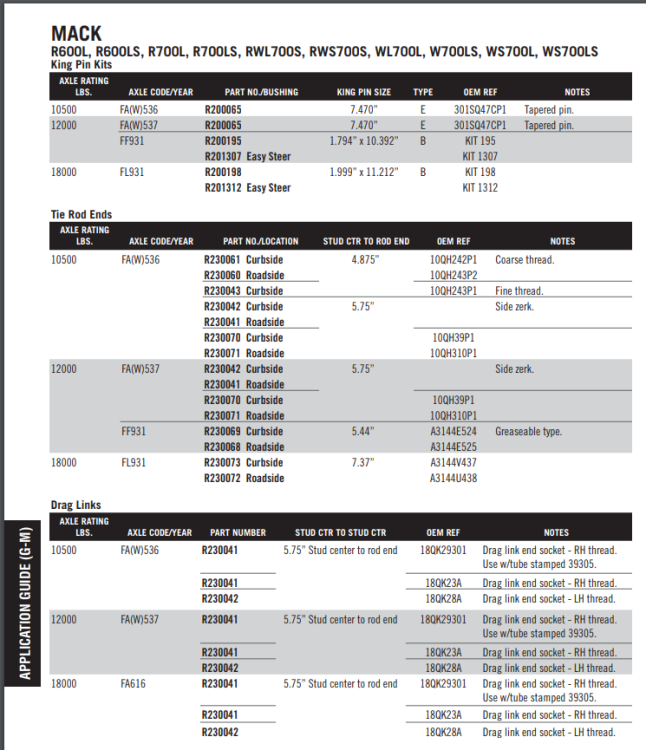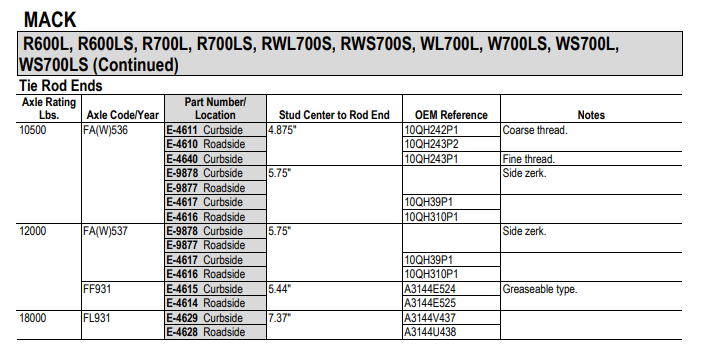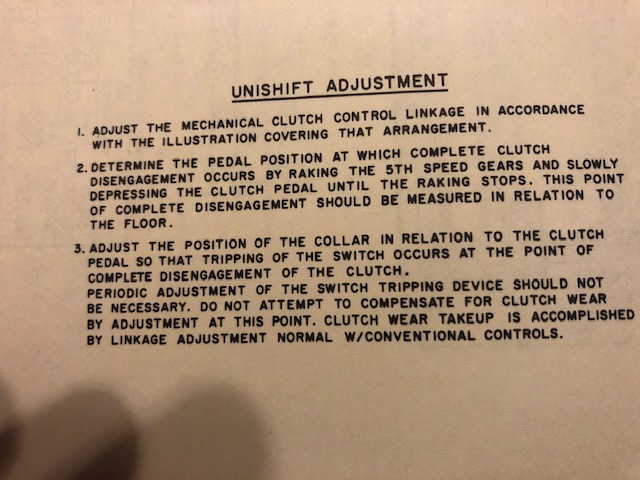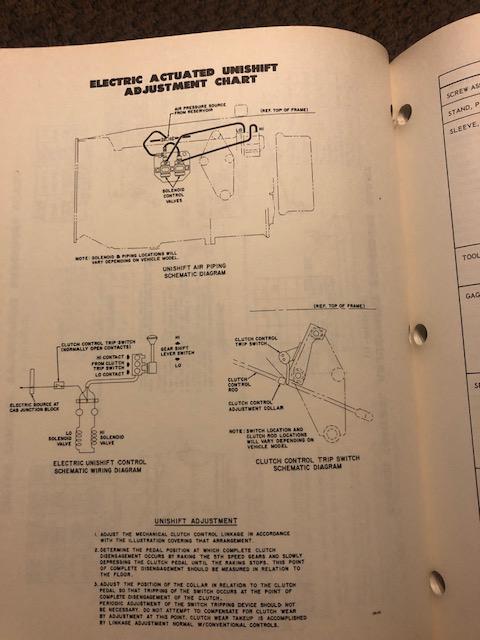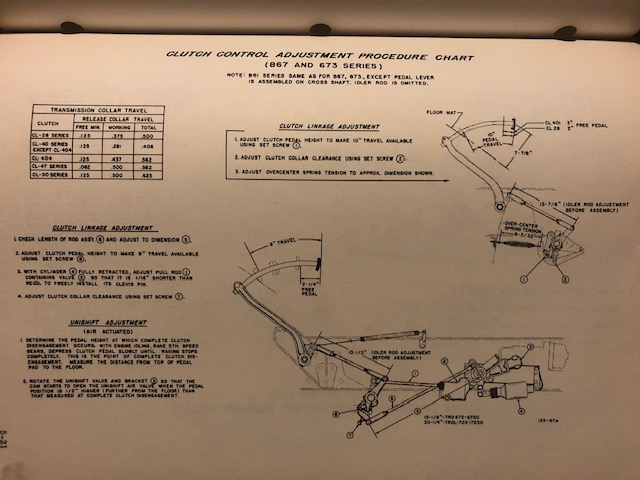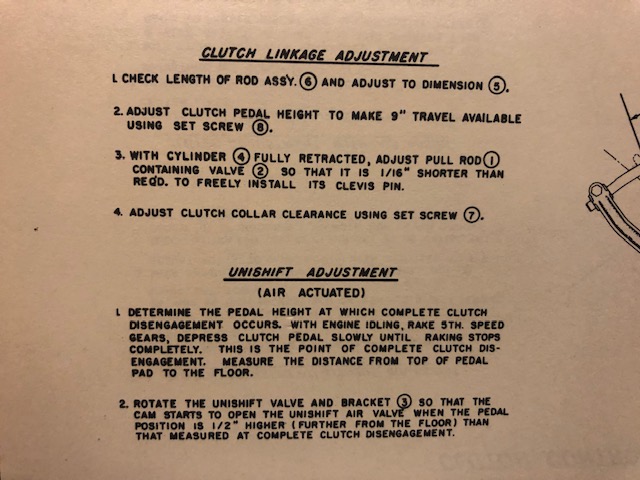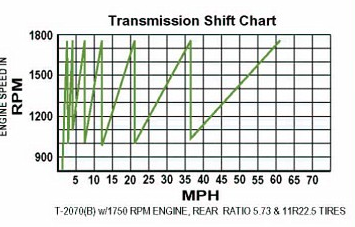-
Posts
2,618 -
Joined
-
Last visited
-
Days Won
37
Content Type
Profiles
Forums
Gallery
Events
Blogs
BMT Wiki
Collections
Store
Everything posted by doubleclutchinweasel
-
What he said. Block heater makes more difference than anything else. On the '70 I had, I found the wiring for the existing block heater folded up and twist-tied together, tucked in behind the oil cooler. Apparently, nobody had ever been aware it was there. I ohmed it out to make sure it wasn't shorted to ground, plugged it in, and voila! Made a huge difference on these cold mornings.
-
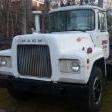
NEED TIE ROD ENDS FOR RL700L
doubleclutchinweasel replied to Scott74's topic in Driveline and Suspension
Once you narrow it down, these suppliers also have the stud and shank dimension listed in their literature. So, you can do a final comparison of the numbers you find with the actual parts on the truck. So, you'll have a pretty good idea if they steered (no pun intended) you in the right direction, even before you start pulling the old stuff out. -
By that time, hadn't Mack already started the "even is gas, odd is diesel" numbering scheme? Hence, A50-gas, A51-diesel?
-

Pulling injectors on a 673
doubleclutchinweasel replied to Craig N's topic in Engine and Transmission
Okay. I haven't had anything to say on this one up until now. Just been enjoying reading it! First off, I have to point out again how similar the Aussies think to us old hillbillies! We seem to try to make the most out of what we've got to work with. Probably for the same reasons! Where I grew up, we didn't have the luxury of trotting down to the local store and grabbing new parts...nor the money to do that. So, we got really good at salvaging what we had and working with what we could get. Anyhow, regardless of whether you can find a newer engine to drop into that thing, I would still be tempted to pull that one all the way down, and for 2 reasons. First, it still may be salvageable. But, even if it isn't, it would be great experience to pull it apart and see how everything inside there works. And what you have left would be no less valuable than what it is now. I once bought 2 400 Pontiac engines for a project I was doing. One was running and the other was locked-up. When it was all said and done, I ended up using way more of the locked-up one than the running one. Anyway, I'll go back over here in the weeds now and just watch what happens! -

NEED TIE ROD ENDS FOR RL700L
doubleclutchinweasel replied to Scott74's topic in Driveline and Suspension
A little more info. A link to a Meritor parts listing and a sample page. Also a Euclid link and a sample page. Notice they even list the Mack-specific combination for one axle where Mack used RH threads on both ends, but with a coarse thread on one and a fine thread on the other. https://dimnsa.com/catalogos/descargas/PB8951 Eje Frontal.pdf https://www.doverbrakeinc.com/downloads/catelogs/EUCLID CATALOG FRONT END 760C.pdf -
Nice!
-

NEED TIE ROD ENDS FOR RL700L
doubleclutchinweasel replied to Scott74's topic in Driveline and Suspension
A good place to start MIGHT be to see if there is a number on the RH end of the axle beam (FA534, FA535, FA536, etc.). This should tell what series the axle is. From there, there are lots of places to look up the ends. Mack has done some strange things through the years on tie rods and ends. But, knowing what axle you have to start with might be a good place to start, at least. -

One armed bandit for a while
doubleclutchinweasel replied to Licensed to kill's topic in Odds and Ends
I can't help but remember this one whenever I hear about a bandsaw incident. Sorry, no pictures. Well, maybe NOT that sorry. Anyway, we had an operator running an automated vertical bandsaw, slotting tapered mounting bushings. These bushings sat on a locating fixture, and the operator presses the Cycle Start button. The saw table would rapid advance to the point where the OD of the bushing would almost touch the saw blade. Then, it would feed slowly through the wall of the bushing. The saw would then rapid across the bore of the bushing, and approach the other side. This wall would then be cut partially through. The table would then retract and the operator could swap out the part for a new one. Repeat ad nauseum. On one cycle, as the blade emerged from the first wall, he stuck his finger in the bore of the bushing and tried to remove it...before it was finished. With the finger securely in the hole in the bushing, the saw rapid advanced to the other side. The blade split his index finger from the tip to the first joint. We called the ambulance. They came and got him. It was several days before he came back. Once back, our safety committee asked him to explain exactly what happened, so they could try to improve the situation. He did a fantastic job of explaining exactly what he did, even pointing out what he did wrong. Problem is, when he demonstrated what he did wrong, he took it a little too far. Using the index finger on the OTHER hand...yep, you guessed it...he actually DID IT AGAIN! We called the ambulance...again. When he returned this time, we kept him far away from things that cut. To this day, that guy has 2 perfectly matched, longitudinally-split forefingers. I'm sure the joints are not perfect either. LTK, glad you are on the way back. And kudos for having the guts to tell what really happened. Best of luck in the recovery. -

1962 Mack B-61
doubleclutchinweasel replied to j hancock's topic in Antique and Classic Mack Trucks General Discussion
I think it sucks. And the only way I can think of to fix its suckiness is to park it in my driveway. Then it would be cool. -

ENDT 673 Liner has pitting, I don't know how???
doubleclutchinweasel replied to Joey Mack's topic in Engine and Transmission
Waiting...waiting...waiting...! -

Pulling injectors on a 673
doubleclutchinweasel replied to Craig N's topic in Engine and Transmission
The '67 I used to drive had a through-the-floor clutch pedal like a B, and a mechanical linkage. The '70 I had used a hanging pedal and a cable. Lots of variations out there. -

Specs on 1960 Model b-61 Mack tractor
doubleclutchinweasel replied to cranemodel1015's topic in Introduction Forum
Those First Gear Diecast trucks are pretty cool. I have several of them. -

B61 unishift linkage schematic and adjustment
doubleclutchinweasel replied to 2ndtime's topic in Engine and Transmission
Here are a couple of pictures from 2 different pages in a service manual. I think one is for air operated and one is for electric. See if any of the notes help with anything. I think B1 and B2 are from the same page, and B3 and B4 are from the other page. -

B61 unishift linkage schematic and adjustment
doubleclutchinweasel replied to 2ndtime's topic in Engine and Transmission
Here is some other discussion from another forum. https://www.smokstak.com/forum/threads/1957-mack-b61-tt-in-tennessee.164568/page-3 -

B61 unishift linkage schematic and adjustment
doubleclutchinweasel replied to 2ndtime's topic in Engine and Transmission
Sounds like there have been issues with these before. One post at the bottom of this thread (below) had some interesting comments about the clutch linkage. -

Specs on 1960 Model b-61 Mack tractor
doubleclutchinweasel replied to cranemodel1015's topic in Introduction Forum
There have been several things posted on here with dimensions on them. B-Model_Cabs.pdf -

B61 unishift linkage schematic and adjustment
doubleclutchinweasel replied to 2ndtime's topic in Engine and Transmission
Let me look tonight. There might be some Unishift info in a service manual I have at home. -

Macks On The Big And Little Screen
doubleclutchinweasel replied to Andy Wright's topic in Mack on the Silver Screen
Sitting here watching “Towing” (1978). Mack C model tow truck. Don’t know if anybody listed this one yet. -

B-73 Restoration
doubleclutchinweasel replied to mattb73lt's topic in Antique and Classic Mack Trucks General Discussion
It's like I said before. Once you go through that engine, it will be as good as the rest of that ride. I'm glad it wasn't worse. I look forward to seeing it back together. -

B42 VALUE
doubleclutchinweasel replied to TIMWAR's topic in Antique and Classic Mack Trucks General Discussion
Different people have different things which are important to them. Me, I don't like to do body work. So, I would pay extra for good sheet metal. Some of these (like Matt) are absolute artists with sheet metal. So, sheet metal work doesn't bother them. If you feel good after buying it, then you got a good deal. -
Did I ever mention that these guys are amazing?!
-

Maxitorque 2070 shifting help
doubleclutchinweasel replied to SpreadingLime's topic in Engine and Transmission
The 1750 engine (I think) were referred to as "limited" or "governed" engines. But, yes, the PERCENTAGE drop or rise would be the same. So, if you can go to 2100, then you would drop to about 1200 instead of 1000. And, you could downshift at 1200, double-clutching up to 2100 to catch the next lower gear. Sounds a lot like your "1200-2100 operating range", doesn't it?! -

Maxitorque 2070 shifting help
doubleclutchinweasel replied to SpreadingLime's topic in Engine and Transmission
Actually, it looks like the ratios in that box ARE pretty widely spaced, requiring lots of "drop" while upshifting and lots of "rise" while downshifting. The MPH on this chart will vary with rear gears and tire sizes. But, the top and bottom of the RPM changes should be constant. Looks like shifting around 1750 will drop you to about 1000 on most shifts (43% RPM drop). Conversely, you would have to pull down to about 1000 before downshifting, double-clutching up to about 1750 to match the gears and let them slide in (75% RPM rise).
BigMackTrucks.com
BigMackTrucks.com is a support forum for antique, classic and modern Mack Trucks! The forum is owned and maintained by Watt's Truck Center, Inc. an independent, full service Mack dealer. The forums are not affiliated with Mack Trucks, Inc.
Our Vendors and Advertisers
Thank you for your support!





